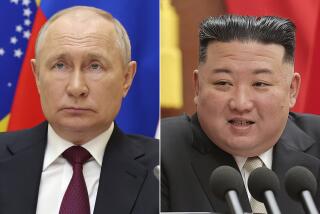Shultz, Shevardnadze Focus on a Minor Arms Accord
- Share via
WASHINGTON — Soviet Foreign Minister Eduard A. Shevardnadze and Secretary of State George P. Shultz completed their first of two days of talks here Thursday with both sides focusing on a minor interim agreement on strategic weapons that would continue the two nations’ arms control momentum.
Shultz considered the five hours of talks--which could be part of the last formal negotiations between the Kremlin and the Reagan Administration--to be “very constructive, very detailed,” a senior U.S. official said later. The subjects ran the gamut from many arms control issues through human rights and regional Third World conflicts.
Shevardnadze’s visit was almost marred by injury to a former Armenian citizen who leaped in front of the Soviet official’s limousine as he was returning to the Soviet Embassy after a State Department luncheon. After the car stopped, Shevardnadze spoke to the man, Ambarsum Khlgatian, 61, who said he has been repeatedly refused a visa to return to Soviet Armenia to visit his mother.
Shevardnadze later told reporters he would “look into” and “take care of” the matter. He did not say he would arrange entry for Khlgatian, who said he had been sentenced to 25 years in labor camps in 1949 for attempting to “escape to the West” and was “kicked out” of the country in 1979.
As the U.S.-Soviet talks opened, Shevardnadze said that “we have specific proposals in many areas.” He singled out ideas for reductions in conventional arms in Europe, noting that there are “some good prospects.”
U.S. officials said, however, that the most promising area for a new agreement emerged from a desire by both sides to break out for a new formal agreement a small piece of the strategic arms reduction treaty that is being negotiated by the superpowers.
Such a move would be comparable to the decision at the Moscow summit in May to formally agree that all ballistic missile flight tests would be announced in advance to avoid any misinterpretation. Until then, only flights involving several launchings at the same time, and those that carried a missile beyond the national borders, were subject to notification by each side.
Each nation is now proposing that a different piece of the proposed strategic arms treaty be put into effect, which could lead to an impasse in the effort. On the other hand, one official said, both measures, or parts of both, may be accepted because they are complementary to a large degree.
Prospects for some “interim” agreement appeared great enough that Senate Majority Leader Robert C. Byrd (D-W.Va.) warned that the Senate would not be bound by such agreements.
Apparently fearing that a new U.S.-Soviet agreement would have political impact favoring Vice President George Bush, Byrd said in a public letter to President Reagan that interim measures “could needlessly complicate the negotiating efforts of the next administration” and “easily raise false expectations” about the successful outcome of negotiations.
In ratifying the medium-range missile treaty in May, he noted, the Senate included an amendment declaring that deals which are not ratified have no binding effect on U.S. forces, but would serve only to guide the conduct of future negotiations.
Ban Proposed
Specifically, the United States quietly proposed last month the banning of encryption, or encoding, of data that is radioed back from missiles during test flights. The United States has long wanted such a ban so that it can evaluate new Soviet missiles better, and Soviet leader Mikhail S. Gorbachev agreed at the summit here last December that the measure would be part of a strategic arms treaty.
The Soviets, without rejecting that idea, have come back with a different proposal. They want to put into effect now the so-called “counting rules” for ballistic missiles that were also accepted at the December summit by Gorbachev and President Reagan.
Under it, each side is committed to a maximum number of warheads on various types of missiles. Among U.S. missiles, the limit would be 10 warheads on the land-based MX missiles, eight on the submarine-launched Tridents 1 and 2; among Soviet weapons, 10 on the SS-24, and one on the SS-25. Some of these intercontinental missiles could carry more warheads but at reduced ranges.
New Forum
In addition to many arms control issues, the talks dealt with the desire by both nations to end the Conference on Security and Cooperation in Europe, now meeting in Vienna, so that a new negotiating forum can be created to discuss cuts in conventional forces.
The United States is insisting on better Soviet performance in human rights issues, including release of political prisoners and increased emigration, as a price for ending the conference and giving the needed mandate to the new conventional arms talks.
More to Read
Sign up for Essential California
The most important California stories and recommendations in your inbox every morning.
You may occasionally receive promotional content from the Los Angeles Times.













